In 2021 the food justice organization Cultivate Charlottesville (“CULTIVATE”) leased 10,000 square feet of space behind the Charlottesville Area Technical Education Center (CATEC) with the intention of developing a new garden to grow crops for distribution to food-insecure space families in the Charlottesville community. At the same time, fresh off a new strategic plan that emphasized building community partnerships, the Piedmont Master Gardeners (PMG) joined them in a supportive partnership that remains active today. This article discusses the results of the efforts CULTIVATE and PMG took to improve soil health in the garden over the following four years.
Getting Going in 2021
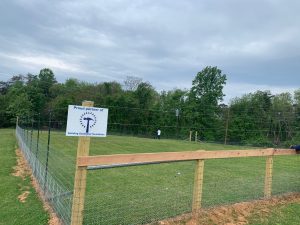
The new garden area had been lawn for a couple of decades (see photo above). It had been regularly mowed each summer, but other care was minimal. In 2020, CULTIVATE, with help from the Building Goodness Foundation, installed a deer fence, and the school installed a well.
In February 2021, CULTIVATE had the soil tested. The results were not great. The pH was quite acidic at 5.4. Organic matter (“OM”) was surprisingly respectable at 4.9%, although 5-10% or higher is realistic and desirable for truly healthy soils. The CEC (cation exchange capacity), a measure of the soil’s ability to hold nutrients for plant accessibility, was 6.0, typical for heavy clay soils with relatively low organic matter. A level of 15-20 is a desirable level for optimizing plant nutrition.

A farmer was hired to till the garden space. Despite making multiple passes over the area, the tractor-pulled tiller was only able to penetrate about 4 inches into the soil, indicating highly compacted clay as the main component.
While there were no crops grown in the garden in 2021, the two groups began testing several methods to get the soil ready for planting. For soil enhancement trials, the space was divided into three sections, each of which was treated to a different soil-improvement method. PMG worked in two 1000 sq. ft. sections, testing cover cropping on one and sheet mulching on the other. CULTIVATE trialed a modified sheet mulch approach in a larger section of the garden. The three different sections were labeled as follows:
–PMG Cover Crop Section
–PMG Sheet Mulch Section
–CULTIVATE Sheet Mulch Section
The PMG Sheet Mulch section was modified by covering the tilled soil with cardboard, adding about 6 inches of a compost/partly decomposed wood chips mix over the area, and then mulching it with 6-8 inches of straw. This section remained untouched until the following spring.
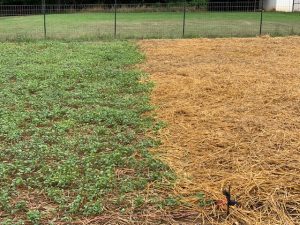

The PMG Cover Crop area was planted twice. Originally, summer buckwheat was planted, then cut after flowering, and followed with a second cover crop in the fall. The second crop was a mix of winter rye, crimson clover, and forage radishes that would provide soil protection through the winter. All but the radishes resumed growth in the spring after winter dormancy. The greens were cut and used as mulch prior to planting and the roots were left in the soil to decompose.
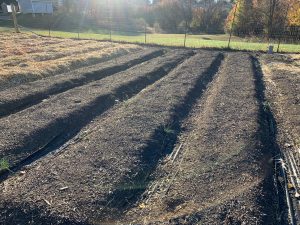
In the CULTIVATE Sheet Mulch area, a heavy layer (6-8 inches) of the compost/wood chip mulch mix was deposited over the south side of the garden area. Raised planting rows were added to support a drip irrigation system. It was covered with straw for the winter.
2022 through 2024: Slow Soil Improvement
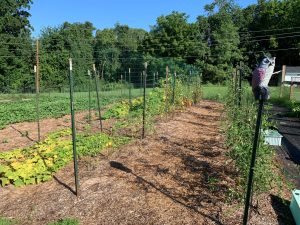
Soil tests over the next three years showed slow improvement in pH and CEC levels. In spring 2024, while we didn’t measure OM levels, pH had increased to a more respectable 6.2, and CEC increased from 6.1 to 9.7 across the garden space, so the soil modifications were having an impact. In any case, crop production increased each year. While there were no further soil or compost additions to the growing areas, regular mulching with straw, cover cropping in winter, and adding some lime to raise pH (as advised by the soil tests) led to slow but steady improvement.
2025 Soil Test Results
In early April this year we took new soil samples from each of the three test areas. The results are compared to 2021 in the chart below:
| CATEC Garden Soil Test by Year | ||||
| Year | Section | OM % | pH | CEC |
| 2021 | Full garden | 4.9 | 5.4 | 6 |
| 2025 | PMG Sheet Mulch | 7.8 | 5.9 | 8.9 |
| PMG Cover Crop | 6.6 | 6.4 | 8.8 | |
| CULTIVATE Sheet Mulch | 18.2 | 6.7 | 15.3 | |
| Full garden 2025 average | 10.9 | 6.3 | 11 | |
Each test was a combination of multiple soil samples from the area being tested, with soil taken from where the crops were planted, rather than from paths or non-growing sections. They were a mix of the compost/mulch additions and the native clay. In each test section, all key measurements were significantly improved compared to the 2021 levels. The CULTIVATE Sheet Mulch section had the highest OM and CEC results and the least acidic pH. Why did the CULTIVATE section show the greatest improvement? This area had the thickest compost/mulch input, which improved every measure including pH (with no lime addition). The PMG Sheet Mulch section showed nice improvement except for pH where no lime was added. Same for the PMG Cover Crop section which also showed decent improvement including pH, probably because we added lime when we planted sweet potatoes in 2023.
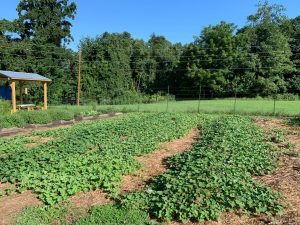
In addition to the characteristics shown in the chart, the macro- and micronutrient content of each of the three soil test areas also improved from low/very low in 2021 to sufficient/high/very high in 2025. This is striking since there was minimal fertilization, indicating the improvement came mainly from soil/compost additions, regular mulching, and cover cropping over the successive years.
Conclusions to date
As the garden completes its fifth year, each of the three areas where soil quality was measured shows significant improvement. The sheet mulched areas are the most improved, illustrating the benefit of significant compost and OM additions, while the cover cropped/mulched areas showed slower but steady progress.
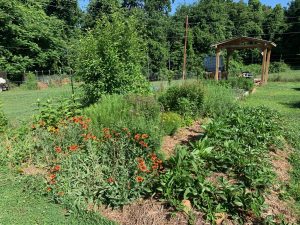
The CULTIVATE team has indicated that they do not use any chemical fertilizers or insecticides. They have used an organic insecticide to a limited degree to help manage cabbage moths and certain insects but work to be as sustainable as possible. They also rotate crops annually to reduce disease risks. I would like to believe that the pollinator garden that PMG installed has increased pollinator and bird activity, also helping to minimize insect and disease issues.
The improvement in soil health seems to validate multiple methodologies. The sections with the highest additions of organic matter through sheet mulching improved fastest. Use of straw mulch during the growing season and across the winter helped maintain moisture, reduce weeds and ultimately add OM to the soil. The Cover Crop Section also improved, although at a slower pace, demonstrating the benefit of keeping the soil covered, and that when combined with straw mulch, cover crops can help build soil organic matter.
Over the winter of 2024/25, the garden was fully cover cropped. This led CULTIVATE to plan to till much of the garden in 2025. PMG opposed tilling and recommended that, instead of tilling, the cover crops should be cut, and that both the roots in the ground and the cut vegetation on the surface be allowed to decompose prior to planting. Tilling can mix organic matter with the native clay, but upsets the soil’s microbe population. This may slow down decomposition of the vegetation being tilled into the soil, reducing plant access to soil nutrients. In addition, tilling can encourage weeds, like the Bermuda grass that was invading the crops. This is because Bermuda grass grows via fast-growing roots called rhizomes, which grow beneath the soil surface and regrow even after being chopped up via tillage. Thus, tilling can lead to aggressive spreading of weeds like the Bermuda grass. In the end, the garden wasn’t tilled, and while weed growth continues to be an issue, this year’s crops have been abundant and healthy.
The garden continues to develop
As soil quality has improved each year, production in the garden has grown due to both increased planting and better soil health. Modifying the compacted native clay to a looser, less acidic more nutritious soil through various combinations of sheet mulching, cover cropping, keeping soil covered year-around, and rotating crop locations has improved soil health and crop production, without chemical fertilizer use.
It is evident that major improvements don’t occur overnight, but the steady improvement is indicative of the merits of the basic organic/regenerative gardening approach, applied in a healthy and sustainable way. PMG looks forward to continuing to work with Cultivate Charlottesville to learn more about soil building as they increase healthy crop production for delivery to food-challenged members of our community.
Application for Home Gardeners
The practices listed in this article are certainly applicable for home gardeners. Adding compost/soil/mulch mixes to garden beds and raised beds can provide a great start to improving soil health. We also recommend soil testing for new gardens and every few years after startup, including measuring organic matter levels (for an additional $4 at the VCE lab) to help assess and manage soil health and productivity. For gardeners interested in more info on soil amendments, check out U of Maryland Extension article Organic Matter and Soil Amendments. Those interested in sheet mulching can benefit from this sheet mulching video from the Penn State Extension.
In any case, we hope gardeners find this article informative and helpful. Wishing everyone great gardening results, this season and in the future.